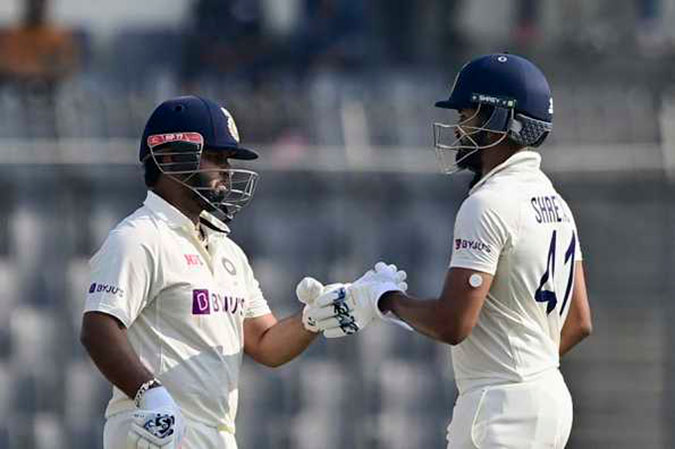Sports
Pant, Iyer put India in strong position

INDIA TOUR OF BANGLADESH 2022
Rishabh Pant (93) and Shreyas Iyer (87) both missed out on centuries but put India in a strong position with a significant 87-run first-innings lead on Day 2 of the second Test in Mirpur. Bangladesh bowlers, led by Taijul Islam (4-74) and skipper Shakib al Hasan (4-79) led the team’s fightback on either side of the damaging 159-run fifth-wicket partnership that came in just 30.1 overs. Bangladesh began on a bright note with Taijul’s triple strikes keeping a tight lid on India’s scoring in the morning session. He became only the second Bangladesh cricketer, after Shakib, to dismiss India’s top-three in an innings.
On a track which still had enough assistance for the bowlers, India’s sedate start to Day 2 was interrupted in the sixth over when KL Rahul was hit flush on the front pad. The loud, confident appeal was turned down on-field but Taijul convinced his captain to opt for a review with three seconds remaining on the clock, and was vindicated. He struck again on the first ball of his next over to take out the other overnight batter, Shubman Gill – trapped plumb in front this time after completely missing his attempted sweep.
While the runs weren’t exactly forthcoming, Cheteshwar Pujara and Virat Kohli stuck it out. The third-wicket pair stitched a handy partnership of 34 but just as they looked settled in, an alert piece of fielding from Mominul Haque at forward short leg got Bangladesh another vital breakthrough. In disbelief, Pujara stood his ground even as the umpires went upstairs to check Bangladesh’s claim of a low catch. The India no. 3 had gently nudged a fuller delivery towards the close-in fielder, and the replays confirmed the catch to be legit.
India could have been in further trouble had Bangladesh latched on to any of the chances offered early on by Pant or Virat Kohli. While the former had slashed at a short and wide delivery from Mehidy Hasan Miraz that was shelled at slip, the latter nearly ran himself out, taking off for a non-existent single last ball before Lunch.
Although Kohli didn’t last long after. Taskin Ahmed, at the beginning of a testing post-Lunch spell, got the former India captain to poke at a delivery outside off and sent him packing for a hard-earned 24. However, that was only the beginning of a two-hour toil for the hosts as Pant and Iyer threw caution to the wind.
The pair transferred the pressure right back onto Bangladesh with a stunning counterattack that turned the game on its head. After being watchful for about a dozen deliveries upfront, Iyer took on the short ball challenge from Taskin and dispatched the pacer for back to back boundaries to get going. The extra bounce did take him by surprise early on. Iyer got away with one he awkwardly pushed at that flew just wide of gully but nearly got caught on 19 one ball later, slashing hard another such ball.
Pant meted out similar treatment to Khaled Ahmed, picking back to back boundaries as the pair raised their fifty stand in under nine overs. He took on Taijul next, merrily slog-sweeping Bangladesh’s best bowler on the day over cow-corner before reaching his own half-century in just 49 deliveries. Iyer got a second life on 21 when Nurul Hasan fluffed a stumping opportunity off Shakib, and the batter made Bangladesh pay immediately with two stunning boundaries – a late-cut and a loft straight down – to close the over leading up to the drinks break.
On the other side, Pant added insult to Shakib’s injury with a one-handed six smoked straight over long-on to force Bangladesh into a bowling change. That proved to be of little help though as the India ‘keeper welcomed Mehidy back into the attack with another maximum that would have ideally been caught at the ropes by the leaping Mushfiqur Rahim. Pant used his feet excellently to put the Bangladesh spinners under pressure, and Taijul was the receiving end once again when the batter brought up the hundred of his partnership with a four and India’s 200 next ball with another brutal hit over long-on ropes. A trademark one-handed 100m strike followed in the next over from Mehidy.
Iyer, who reached his second successive fifty of the series just before heading for Tea, put India in a lead with a brace right after. He then went on to raise both the impending milestones – 150 of the fifth-wicket partnership and India’s 250 – with a four each. But Shakib played the architect of Bangladesh’s little fightback in the evening that saw India lose their last six wickets for just 64 once Mehidy had managed to break the stand at 159.
Visibly in some discomfort, Pant fell in the 90s for the sixth time in Test cricket when he gently poked at a delivery spinning away from him to send an edge to the keeper. Axar Patel walked out ahead of Ashwin to help India maintain the left-right combination but departed cheaply, trying to take the aerial route against Shakib.
The Bangladesh skipper picked up the bigger prize in his next over, trapping Iyer plumb in front when he missed his sweep. Just 13 away from his century, the India batter opted for a desperate review but to no avail. Bangladesh had sent a couple of calls upstairs before Ashiwn was finally given out LBW to Shakib, who picked his third in quick succession.
Once Umesh Yadav had pushed India past the 300-run mark with his boundary-filled little cameo of 14, Taijul had him edging to slip for his fourth while Shakib got there a couple of overs later when Siraj slogged and missed and Nurul was quick to dislodge the bails.
With the pitch only getting tougher to bat on as the game progresses, India’s lead of 87 could prove quite handy. Bangladesh openers did manage to bring it down to 80 while safely negotiating a tricky phase of six overs under lights before the stumps were drawn.
Brief scores:
Bangladesh 227 & 7/0, trail India 314 (Rishabh Pant 93, Shreyas Iyer 87; Taijul Islam 4-75, Shakib al Hasan 4-79) by 80 runs. (Cricbuzz)
Latest News
Rodrigues fifty leads India’s chase after bowlers set up victory against Sri Lanka

There was a little bit of rustiness as India returned to action 50 days after becoming ODI world champions, but not so much to prevent them from registering a dominant win in the first T20I against Sri Lanka in Visakhapatnam.
Despite dew being a constant presence on a cool evening, India’s spinners rallied to keep Sri Lanka’s top order in check – even if they did not pick up wickets in a heap – thus restricting them to 121 for 6. It was a below-par total given that the dew was only going to increase as the temperatures reduced – something Harmanpreet Kaur had alluded to while choosing to chase at the toss. India made easy work of it to get home with eight wickets and 32 balls to spare, starting their road to the T20 World Cup 2026 in June on the right note.
Jemimah Rodrigues, batting for the 100th time in T20Is, struck a 14th half-century in the format to help the hosts canter. There was a mild intrigue around India’s No. 3, with Harleen Deol batting at that spot for two games in England, and Harmanpreet signaling her intent to be India’s one drop at the last T20 World Cup. But Rodrigues’ 69 not out from 44 balls should dispel any doubts India would have had.
This was India’s sixth win in ten games since being knocked out in the league stage of the 2024 iteration.
Brief scores:
India Women 122 for 2 in 14.4 overs (Jemimah Rodrigues 69*, Smriti Mandhana 25, Harmanpreet Kaur 15*; Kawya Kavindi 1-20, Inoka Ranaweera 1-17) beat Sri Lanka Women 121 for 6 in 20 overs (Vishmi Gunaratne 39, Chamari Athapaththu 15, Hasini Perera 20, Harshita Samarawickrama 21; Deepti Sharma 1-20, Kranti Gaud 1-23, Shree Charani 1-30) by eight wickets
[Cricinfo]
Latest News
Sameer Minhas 172 powers Pakistan to Under-19 Asia Cup title

Opener Sameer Minhas blitzed his way to 172 off 113 balls, setting up Pakistan’s demolition of India in thDeepeshe Under-19 Asia Cup final in Dubai. In response to Pakistan’s 347 for 8, India folded for 156 in 26.2 overs.
Minhas’ knock was the highest individual score for Pakistan, and also, the highest individual score by any batter in a final in Youth ODIs. He hit 17 fours and nine sixes during his stay, and fell in the 43rd over, finishing with a strike rate of 152.21.
In response, Vaibhav Suriyawvanshi – having scored 5, 50, 9 and 26 in tournament since his 171 against UAE – made an explosive start to India’s chase. He smashed three sixes and a four, but Ali Raza had him nicking off for 26 off 10 balls. India had reached their fifty in the fifth over and by the end of the powerplay, they were 68 for 5.
Pakistan came into the final having bowled out each of their opposing batting line-ups in the tournament. This contest was no different – four Pakistan bowlers shared wickets among them, with Raza prising out three more wickets to finish with match figures of 4 for 42.
India were reduced to 120 for 9, but Deepesh Devendran offered some late resistance with 36 off 16 balls, including six fours and two sixes. No other India batter passed 30 in the chase. India’s innings ended when Raza had Devendran holing out in the 27th over.
Earlier in the day, Devendran had copped punishment from the Pakistan batters, conceding 83 runs in his ten overs though he took three wickets at the death.
Minhas was well-supported by Ahmed Hussain – the only other batter to cross fifty in the innings. Hussain made 56 off 72 balls and added 137 for the third wicket along with Minhas.
Pakistan faced a slight slowdown in the death overs, especially once Minhas was dismissed – they only managed 71 runs in the final ten for the loss of five wickets. Devendran took three of those wickets, but his death bowling was a footnote by the time he swung for the hills in India’s chase, and was eventually caught at point.
Pakistan wrapped up a 191-run win and tuned up nicely for the upcoming Under-19 World Cup.
Brief scores:
Pakistan Under 19s 347 for 8 in 50 overs (Sameer Minhas 172, Ahmed Hussain 56, Usman Khan 35; Henil Patel 2-62, Deepesh Devendran 3-83, Khilan Patel 2-44 ) beat India Under 19s 156 in 26.2 overs (Deepesh Devendran 36, Vaibhav Suryawanshi 26; Ali Raza 4-42, Mohammed Sayyam 2-38, Huzaif Ahsan 2-12) by 191 runs
[Cricinfo]
Latest News
No Christmas miracle for England as Australia make it 3-0 to retain the Ashes in 11 days

In the third Test, they rose again, but there was to be no Christmas miracle. Despite a gutsy fight from England’s lower order that hauled an already lost cause deep into the afternoon session of the final day, Australia held their nerve – and their catches – to seal the 2025-26 Ashes with their third victory in a row on only the 11th day of the series.
The winning moment was delivered by Scott Boland, who induced a thick edge from England’s No. 11 Josh Tongue, straight to Marnus Labuschagne at first slip, who swallowed his fourth take of a truly sensational display in the field. That left Brydon Carse high and dry on 39 not out; his efforts, alongside fighting but ultimately thwarted knocks of 60 and 47 from Jamie Smith and Will Jacks. had given England genuine hope that their performances at other key moments of the Test and the series, simply hadn’t warranted.
Labuschagne’s efforts included his second one-handed screamer of the match, this time to prise out Jacks at first slip, and it was a fitting reminder of one of the key differences between the sides. The winning margin of 82 runs was exactly the same score that Usman Khawaja had reached on the first day of the match, after being dropped by Harry Brook on 5, while the 71 runs that Travis Head made after the same fielder had reprieved him on 99 would prove to be the death knell of England’s series hopes.
And yet hope is most certainly what England had, right up until the moment it was finally snuffed out, and by a familiar nemesis.
For the first time in the series, the Player-of-the-Match award would elude Mitchell Starc, but his claim to the Compton-Miller Medal is now beyond any further discussion. On a day when Australia’s resources were stretched by a potentially series-ending injury to Nathan Lyon, Starc stepped up with the first three of the final four wickets required. His left-arm angles and command of seam and swing were able to extract rare life from an unthreatening Adelaide surface, and once armed with the harder new ball, the end was always nigh despite England’s doughtiest day’s work of the series.
The day of reckoning had dawned with 17 overs remaining until Australia’s new ball, so Lyon and Cameron Green shared the early workload to keep the senior seamers fresh. Despite some early alarms against the short ball, Smith and Jacks settled quickly into a confident stand, with Smith smashing a brace of sixes over the leg-side off spin and seam alike to whittle the requirement below 200.
It was a boon for the Barmy Army on an overcast morning, and their ever-mounting optimism reached an early crescendo midway through the day’s 11th over, when a persistent shower blew across the ground to force a 40-minute delay.
Jacks brought up the fifty stand soon after the resumption, but the biggest moment of the morning came one over later. Lyon, at fine leg, dived valiantly to intercept a Jacks pull, but was in obvious discomfort as he clambered back to his feet. It was instantly apparent that he’d damaged his right hamstring, and as the physio came out to assist him back to the dressing-room, his involvement in the series – as with his torn calf at Lord’s in 2023 – appeared to have come to an abrupt end.
That was the cue for England to step up their tempo. With the new ball looming, Smith cracked three fours in a row off the part-time spin of Travis Head and Marnus Labuschagne, and then – having taken a few sighters as Mitchell Starc and Pat Cummins re-entered the attack – decided the new ball had to travel as well.
Smith reeled off a quartet of superb, imposing boundaries – two in a row off each man, including a straight-batted launch through long-off off Cummins to bring up his first fifty of the series. But just when it seemed he’d rocked Australia back on their heels, Smith attempted one big shot too many: a wild pick-up across the line off Starc. Cummins at wide mid-on backpedalled to swallow the chance, before turning to the crowd to celebrate with a combination of triumph, and some relief.
It was all too familiar from an England point of view: opportunity not so much knocking as ding-dong-ditching, as another moment of optimism came and went with indecent haste. Jacks, however, stayed true to the methods that had served him well in adversity at the Gabba, remaining watchful outside off and dealing largely in nudged singles square of the wicket. Despite one alarming deviation from that norm – a pre-meditated whip to leg off Cummins that he was lucky not to snick to the keeper – he and Carse carried England through to lunch on 309 for 7, a deficit of 126.
Australia thought they had their breakthrough shortly after the resumption, as Cummins pinned Carse on the pad, but umpire Nitin Menon’s verdict was a shocker – the ball was shown to be missing a second middle stump, and Carse, on 15 at the time, marched on. He responded to the reprieve by planting Head’s part-time spin over deep midwicket for six, and when he flicked Boland off his pads through fine leg, he had hauled the requirement down to double figures.
Australia, however, were starting to create chances and pressure with seam at both ends, and two balls later, Starc served up a wobble-seam outside off, and Labuschagne sprung to his left at first slip to pluck a fat edge in one hand, almost out of Alex Carey’s waiting gloves.
The end was nigh. Carse was dropped by Green at second slip – standing so close to ensure every half-chance carried – and even Carey, Player of the Match for a peerless performance both in front and behind the stumps, endured a rare blemish as Archer snicked one into his elbow: had he been standing back to Boland, it would have been a regulation take.
It mattered not, however. Archer has been one of England’s batters of the series to date – which, for a No.10/11 is a damning indictment of their efforts – but this time he couldn’t be the hero. A slashing cut at Starc picked out deep point, and eight balls later, Australia’s fourth home Ashes in a row was in the bag, and once again at the earliest opportunity.
Brief scores:
Australia 371 and 349 (Travis Head 170, Alex Carey 72; Josh Tongue 4-70, Brydon Carse 3-80) beat England 286 and 352 (Zak Crawley 85, Jamie Smith 60, Will Jacks 47; Mitchell Starc 3-42, Pat Cummins 3-48, Nathan Lyon 3-77) by 82 runs
[Cricimfo]
-

 Midweek Review5 days ago
Midweek Review5 days agoHow massive Akuregoda defence complex was built with proceeds from sale of Galle Face land to Shangri-La
-

 News4 days ago
News4 days agoPope fires broadside: ‘The Holy See won’t be a silent bystander to the grave disparities, injustices, and fundamental human rights violations’
-

 News4 days ago
News4 days agoPakistan hands over 200 tonnes of humanitarian aid to Lanka
-

 News5 days ago
News5 days agoBurnt elephant dies after delayed rescue; activists demand arrests
-

 Business3 days ago
Business3 days agoUnlocking Sri Lanka’s hidden wealth: A $2 billion mineral opportunity awaits
-

 Editorial5 days ago
Editorial5 days agoColombo Port facing strategic neglect
-

 News3 days ago
News3 days agoArmy engineers set up new Nayaru emergency bridge
-

 News5 days ago
News5 days agoSri Lanka, Romania discuss illegal recruitment, etc.



















